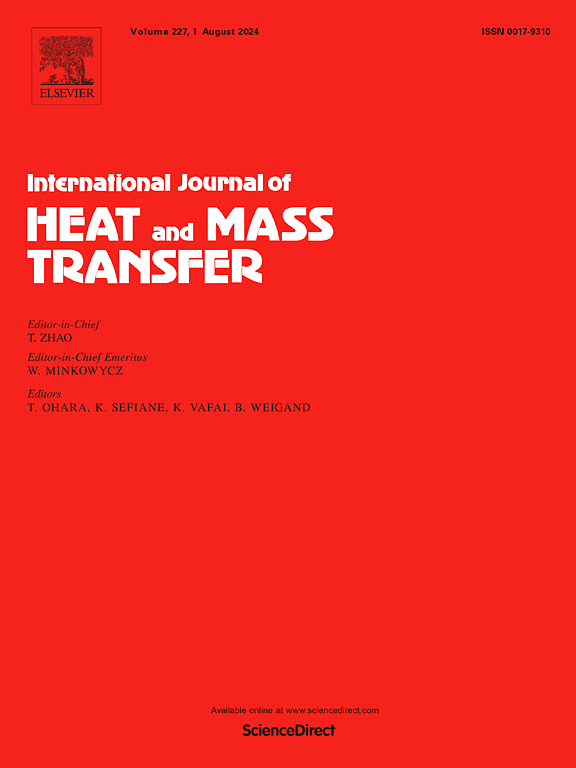Numerical investigation on aerothermal performances of film cooled high pressure turbine vane under inlet non-uniformities
IF 5
2区 工程技术
Q1 ENGINEERING, MECHANICAL
International Journal of Heat and Mass Transfer
Pub Date : 2024-11-12
DOI:10.1016/j.ijheatmasstransfer.2024.126398
引用次数: 0
Abstract
Lean-premixed combustion technologies have been widely adopted in advanced civil turbofan engine to reduce NOx emission. There exist hot streak (HS) and swirl simultaneously at the exit of lean-premixed combustor. Current paper presents a numerical investigation on the aerothermal performances of film cooled high pressure turbine (HPT) nozzle guide vane (NGV) subjected to HS and swirl. Current investigation was carried on the stage one film cooled NGV of GE-E3 HPT, which took into consideration the realistic clocking position of HPT NGV relative to the fuel injector in combustor. The effects of swirl orientations on the migration of HS and film coolant and the aerothermal performances on NGV surface were examined. Results demonstrates that, swirl and its induced incidence angle effect turn over some film coolant from pressure side (PS) to suction side (SS), or vice versa. Such effects also dominate the radial migration of film coolant. The redistributions of film coolant show significant effect on the film cooling effectiveness on NGV surface. Compared with no-swirl case, the greater film cooling effectiveness appears at the region where film coolant accumulates, and as expected, the smaller film cooling effectiveness arises at the region covered by less film coolant. As for heat transfer coefficient (HTC), swirl affects HTC on NGV surface mainly through redistributing film coolant and the hot fluid from HS. The migrations of film coolant and hot fluid keep step with each other on the NGV surfaces directly impinged by inlet HS and swirl, so that the HTC distributions on these surfaces are not significantly affected by swirl. The radial momentum of film coolant endowed by the film hole with radial incidence angle can partly offset the swirl's induced incidence angle effect, which reduces the variations in film cooling effectiveness and heat transfer coefficient due to swirl.
入口不均匀条件下薄膜冷却高压涡轮叶片气热性能的数值研究
为减少氮氧化物的排放,先进的民用涡扇发动机广泛采用了贫油预混燃烧技术。贫油预混燃烧器出口处同时存在热条纹(HS)和漩涡。本文对薄膜冷却高压涡轮(HPT)喷嘴导叶(NGV)在热条纹和漩涡作用下的气动热性能进行了数值研究。本次研究针对 GE-E3 HPT 的一级薄膜冷却 NGV,考虑了 HPT NGV 相对于燃烧器中燃料喷射器的实际时钟位置。研究了漩涡方向对 HS 和薄膜冷却剂迁移的影响以及 NGV 表面的气热性能。结果表明,漩涡及其诱导的入射角效应会使一些薄膜冷却剂从压力侧(PS)转向吸气侧(SS),反之亦然。这种效应还主导着冷却液薄膜的径向迁移。薄膜冷却剂的重新分布对 NGV 表面的薄膜冷却效果有显著影响。与无漩涡情况相比,在薄膜冷却剂聚集的区域,薄膜冷却效果较强,而在薄膜冷却剂覆盖较少的区域,薄膜冷却效果较弱。至于传热系数(HTC),漩涡主要通过重新分配膜冷却剂和来自 HS 的热流体来影响 NGV 表面的 HTC。在直接受到入口热交换器和漩涡冲击的 NGV 表面上,膜冷却剂和热流体的迁移保持同步,因此这些表面上的 HTC 分布不会受到漩涡的明显影响。具有径向入射角的膜孔赋予膜冷却剂的径向动量可以部分抵消漩涡的诱导入射角效应,从而减小漩涡对膜冷却效果和传热系数的影响。
本文章由计算机程序翻译,如有差异,请以英文原文为准。
求助全文
约1分钟内获得全文
求助全文
来源期刊
CiteScore
10.30
自引率
13.50%
发文量
1319
审稿时长
41 days
期刊介绍:
International Journal of Heat and Mass Transfer is the vehicle for the exchange of basic ideas in heat and mass transfer between research workers and engineers throughout the world. It focuses on both analytical and experimental research, with an emphasis on contributions which increase the basic understanding of transfer processes and their application to engineering problems.
Topics include:
-New methods of measuring and/or correlating transport-property data
-Energy engineering
-Environmental applications of heat and/or mass transfer

 求助内容:
求助内容: 应助结果提醒方式:
应助结果提醒方式:


